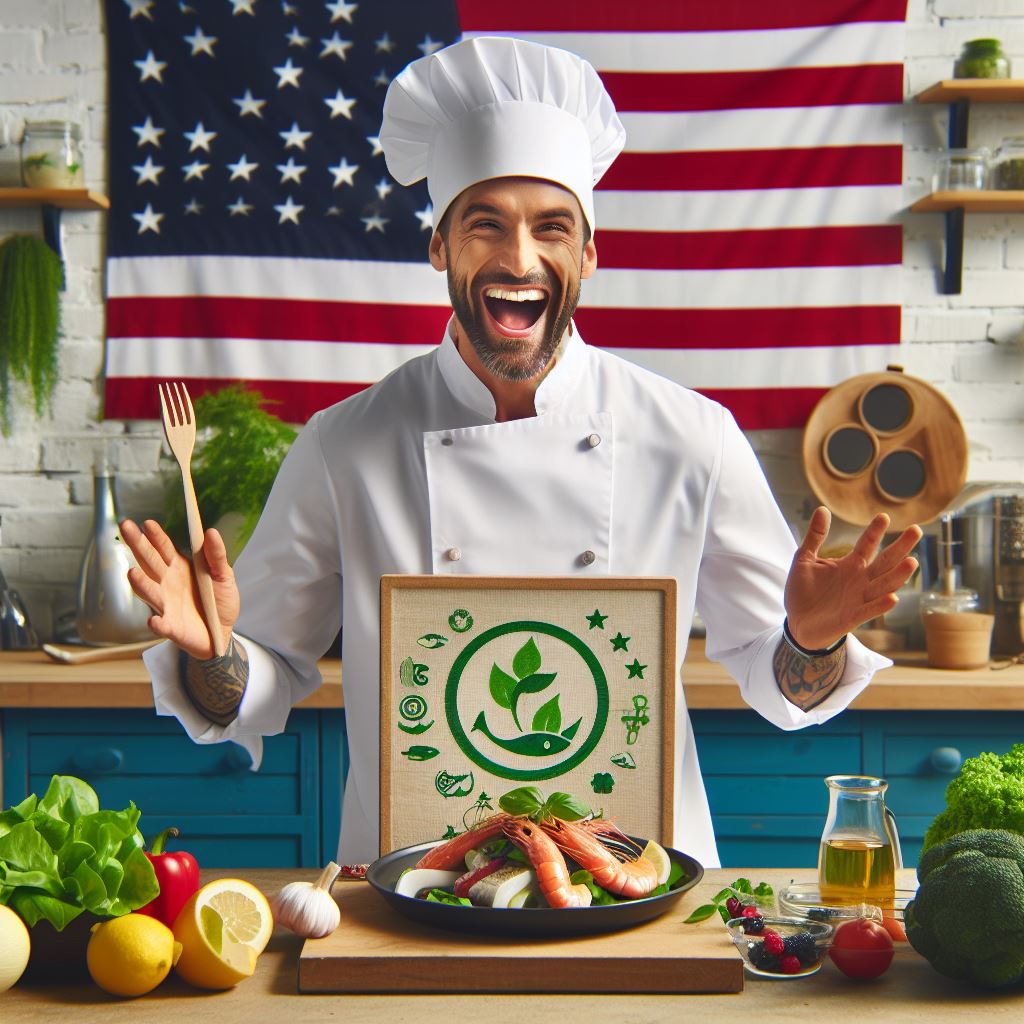Introduction
Welcome to our cooking guide on sustainable seafood!
In this blog post, we will explore the importance of consuming sustainable seafood and provide an overview of the content you can expect to find.
Definition of sustainable seafood
Sustainable seafood refers to fish and other aquatic species that are caught or farmed using practices that minimize the impact on the environment and ensure the long-term health of the species.
Importance of consuming sustainable seafood
By choosing sustainable seafood, we can support the conservation of marine ecosystems, protect vulnerable species, and help maintain the balance of our oceans.
It also ensures future generations can continue to enjoy seafood.
Overview of the cooking guide content
In this guide, we will provide tips on how to identify and select sustainable seafood options at the grocery store or fish market.
We will also offer delicious and easy-to-follow recipes that showcase sustainable seafood in various cuisines and cooking styles.
You can expect to find information on different types of sustainable seafood, including fish, shellfish, and crustaceans.
We will also discuss the importance of sustainable fishing methods and responsible aquaculture practices.
Whether you are a seasoned chef or a novice cook, this guide will equip you with the knowledge and skills to make informed choices when it comes to sustainable seafood and create delightful dishes that are both healthy and environmentally friendly.
Together, let’s embark on this culinary journey that celebrates the bounties of the sea while preserving its precious resources for future generations.
Identifying Sustainable Seafood
Certification Programs
- Certification programs like MSC (Marine Stewardship Council) play a crucial role in promoting sustainable seafood.
- MSC certification ensures that the fishery follows sustainable fishing practices and has minimal environmental impact.
- Look for the MSC label on seafood products, indicating their sustainability and compliance with strict standards.
- Other reputable certification programs include ASC (Aquaculture Stewardship Council) for sustainable aquaculture practices.
Criteria for Choosing Sustainable Seafood
- Opt for seafood species that are abundant and not overfished. Avoid endangered or vulnerable species.
- Choose locally sourced seafood to support sustainable fishing practices and reduce transportation emissions.
- Consider the fishing methods used. Select seafood caught with low-impact techniques like pole-and-line, handline, or traps.
- Avoid seafood from poorly regulated or illegal fisheries, as they can contribute to overfishing and habitat destruction.
Tips for Reading Labels and Identifying Sustainable Options
- Look for clear and trustworthy eco-labels indicating sustainability certification.
- Beware of misleading labels, such as terms like “natural” or “ocean-friendly,” which may lack specific sustainability criteria.
- Research online or use mobile apps to access seafood guides that provide information on sustainable options.
- Consult seafood watch programs run by reputable organizations like Monterey Bay Aquarium or WWF for guidance on sustainable choices.
Reading Precautions
- Avoid seafood without any labeling or sustainability information.
- Be skeptical of exaggerated claims like “100% sustainable,” as they may be misleading.
- Cross-reference different sources and certifications to ensure accuracy in identifying sustainable options.
By choosing sustainable seafood, we can contribute to the conservation of marine ecosystems and support responsible fishing practices.
Remember to check certification labels, consider criteria for sustainability, and stay informed through reliable sources.
Together, we can make a positive impact on the future of our oceans.
Read: Farmers’ Markets: A Shopper’s Guide
Transform Your Agribusiness
Unlock your farm's potential with expert advice tailored to your needs. Get actionable steps that drive real results.
Get StartedSeasonality and Locally Sourced Seafood
Benefits of Consuming Seasonal Seafood
- Fresher Taste: Seasonal seafood is usually caught and harvested at its peak freshness, ensuring a more flavorful dining experience.
- Environmental Sustainability: By consuming seasonal seafood, you support sustainable fishing practices and help maintain healthy fish populations.
- Nutritional Value: Seasonal seafood is typically more nutritious as it contains higher levels of essential vitamins and minerals.
- Cost-Effective: Purchasing seasonal seafood can save you money since it is more abundant and readily available.
Guide on Selecting Seafood Based on Local Availability
- Research Local Sources: Identify reputable seafood markets or fishmongers in your area that source seafood locally.
- Check for Certifications: Look for labels such as “MSC-certified” or “sustainably sourced” to ensure you’re buying responsibly harvested seafood.
- Visit Farmers’ Markets: Local farmers’ markets often have vendors offering fresh, locally caught seafood.
- Seek Recommendations: Ask local chefs, fishermen, or knowledgeable seafood enthusiasts for recommendations on what’s in season and locally available.
- Be Mindful of Seasons: Different fish species have specific seasons when they are at their peak, ensuring optimal flavor and sustainability.
Recipes that Highlight Seasonal and Regional Ingredients
Grilled Lemon Herb Salmon
- Marinate fresh, locally sourced salmon fillets in a mixture of lemon juice, herbs, and olive oil.
- Grill to perfection and serve alongside seasonal grilled vegetables for a delicious and healthy meal.
Spicy Shrimp Tacos
- Sauté locally caught shrimp with a blend of spices, such as chili powder, cumin, and paprika.
- Assemble the spicy shrimp in warm tortillas and top with fresh, seasonal salsa made with local ingredients.
Roasted Cod with Citrus Salsa
- Season locally caught cod fillets with salt, pepper, and a hint of smoked paprika.
- Roast in the oven and serve with a zesty citrus salsa made from locally sourced oranges, grapefruits, and cilantro.
Pan-Seared Scallops with Asparagus
- Sear local scallops in a hot pan with butter until golden brown and perfectly cooked.
- Serve alongside sautéed asparagus, seasoned with garlic and lemon zest, for a delightful seasonal dish.
By embracing seasonal and locally sourced seafood, you not only enhance the flavors of your meals but also contribute to the preservation of marine ecosystems.
Explore the bounties of your local waters and enjoy the sustainable and delectable seafood available throughout the year.
Read: Winter’s Harvest: Cooking Seasonal Produce
Low-Impact Fishing Methods
When it comes to sustainability, it is crucial to understand the different fishing methods and their impact on the environment.
By choosing seafood caught using low-impact techniques, we can contribute to the long-term health of our oceans and marine life.
Here, we will discuss various fishing methods and provide recommendations for specific low-impact techniques along with their associated seafood.
Pole and Line Fishing
- Pole and line fishing is a low-impact method that involves using a fishing pole and baited hooks.
- This technique reduces bycatch and minimizes habitat destruction, making it one of the most sustainable methods.
- It is commonly used for catching tuna, mackerel, and other pelagic fish.
Handline Fishing
- Handline fishing is similar to pole and line fishing, but it is done using a single line held in the hand.
- It is a selective method, targeting specific fish species while minimizing bycatch.
- Popular handline-caught seafood includes snapper, grouper, and mahi-mahi.
Trap/Pot Fishing
- Trap or pot fishing involves using cages or baskets baited with food to capture fish.
- This method has low levels of habitat damage and bycatch, making it environmentally friendly.
- Seafood such as crab, lobster, and shrimp are commonly caught using traps or pots.
Spearfishing
- Spearfishing is a traditional fishing technique that involves using a spear to catch fish.
- It is a selective method that allows fishermen to choose their targets and avoid unwanted species.
- Popular spearfishing catches include snappers, groupers, and various reef fish.
Trawl and Purse Seine Fishing
- Trawling and purse seine fishing are more commonly associated with high impact and bycatch.
- These methods involve dragging nets through the water, capturing both target and non-target species.
- It is recommended to avoid seafood caught using these methods to minimize environmental impact.
Choosing Sustainable Seafood
While selecting seafood, it is essential to consider not only the fishing method but also the sustainability of the species itself.
Look for certifications such as the Marine Stewardship Council (MSC) or the Aquaculture Stewardship Council (ASC) on the packaging.
These certifications ensure that the seafood is sourced responsibly and sustainably.
Additionally, local and seasonal seafood is often a better choice as it reduces the carbon footprint associated with transportation and supports local fishers.
By opting for seafood caught using low-impact fishing methods, we can make a positive impact on the oceans’ health.
Pole and line fishing, handline fishing, trap/pot fishing, and spearfishing are all sustainable alternatives.
Remember to also consider certifications and choose local, seasonal seafood to promote sustainability further.
Together, let’s strive for a future where sustainable seafood is the norm, ensuring that the beauty and abundance of our oceans last for generations to come.
Read: Herbs and Spices: Grow Your Own
Farming and Aquaculture
Pros and Cons of Seafood Farming (Aquaculture)
Pros
- Aquaculture provides a controlled environment for fish breeding, resulting in a consistent supply of seafood.
- It reduces the pressure on wild fish populations, helping to protect and restore marine biodiversity.
- Farmed seafood often requires less feed conversion, making it more efficient in terms of resources.
- Aquaculture can provide employment opportunities and contribute to local economies in coastal communities.
- It allows for the production of specific species that are not easily available through other means.
Cons
- There is a risk of diseases spreading within aquaculture farms due to the high density of fish.
- Escapes of farmed fish can lead to the transmission of diseases and the potential interbreeding with wild populations.
- Fish farming requires large amounts of feed, which can lead to overfishing of other marine species for feed production.
- Some aquaculture methods can result in pollution of waterways due to excessive use of chemicals and waste discharge.
- Farmed fish may be genetically modified or will have lower nutrition levels compared to wild-caught fish.
Sustainable Aquaculture Practices
- Look for seafood that has been certified by reputable organizations like the Aquaculture Stewardship Council (ASC) or the Marine Stewardship Council (MSC).
- Choose fish that have been raised in open-water systems or low-density farms to reduce the risk of diseases.
- Opt for species that are fast-growing and have a low impact on the environment, such as barramundi or tilapia.
- Support aquaculture operations that use environmentally friendly feed sources and minimize waste discharge.
- Avoid seafood from farms located in sensitive ecosystems or areas with high risk of pollution.
Recipes Incorporating Sustainably Farmed Seafood
Pan-Seared Barramundi with Roasted Vegetables
Ingredients
- 2 barramundi fillets
- Assorted vegetables (carrots, zucchini, bell peppers)
- Olive oil
- Salt and pepper
Directions
- Preheat the oven to 400°F (200°C) and prepare a baking sheet.
- Toss the vegetables with olive oil, salt, and pepper, and spread them on the baking sheet.
- Place the barramundi fillets on a separate baking sheet, season with salt and pepper.
- Heat a skillet over medium-high heat and add olive oil.
- Cook the barramundi fillets for about 3-4 minutes on each side, until the flesh is opaque and flaky.
- Remove the barramundi and place on top of the roasted vegetables. Serve hot.
Tilapia Tacos with Mango Salsa
Ingredients
- 4 tilapia fillets
- 8 tortillas
- 1 mango, diced
- 1/2 red onion, finely chopped
- 1 jalapeno, seeded and minced
- Fresh cilantro, chopped
- Lime juice
- Salt and pepper
Directions
- Grill or pan-sear the tilapia fillets until cooked through, approximately 3-4 minutes on each side.
- Warm the tortillas on a skillet or grill.
- In a bowl, combine the diced mango, red onion, jalapeno, cilantro, lime juice, salt, and pepper.
- Flake the tilapia and divide it among the tortillas.
- Top with the mango salsa and serve with lime wedges.
Read: Organic Food Myths: Facts You Should Know

Ethical Considerations
When it comes to sustainable seafood, ethical considerations play a significant role.
Issues like bycatch and overfishing need to be addressed to ensure a healthy marine ecosystem for future generations.
Addressing Issues Like Bycatch and Overfishing
Bycatch, the unintentional catching of species while fishing for a target species, is a major ethical concern in the fishing industry.
It often leads to the unnecessary death of dolphins, turtles, seabirds, and other marine animals.
To address this issue:
- Fishermen should use more selective fishing gear, such as circle hooks and TEDs (Turtle Exclusion Devices), to reduce bycatch.
- Regulations should be put in place to limit bycatch, and penalties must be enforced to discourage non-compliance.
- Consumers can support sustainable fishing practices by choosing seafood products labeled as “bycatch-free” or “dolphin-safe.”
Overfishing, the depletion of fish populations due to excessive fishing, is another ethical concern.
It disrupts marine ecosystems and threatens the livelihoods of fishing communities.
To tackle overfishing:
Showcase Your Farming Business
Publish your professional farming services profile on our blog for a one-time fee of $200 and reach a dedicated audience of farmers and agribusiness owners.
Publish Your Profile- Government agencies should implement and enforce strict fishing quotas and catch limits.
- Consumers can opt for seafood that is certified sustainable by organizations like the Marine Stewardship Council (MSC) or the Aquaculture Stewardship Council (ASC).
- Choosing locally caught seafood reduces the carbon footprint associated with long-distance transportation and supports small-scale fishermen.
Steps Consumers Can Take to Promote Ethical Seafood Consumption
Consumers hold the power to drive positive change in the seafood industry through their purchasing decisions.
Here are some steps they can take to promote ethical seafood consumption:
- Educate themselves about sustainable fishing practices and become aware of the ethical concerns associated with various seafood choices.
- Look for seafood products that display certifications from reputable organizations like MSC, ASC, or the Best Aquaculture Practices (BAP).
- Choose seafood that is sourced from well-regulated fisheries or responsibly managed aquaculture operations.
- Support local, small-scale fishermen and fisherwomen who follow sustainable practices.
- Reduce seafood consumption and diversify protein sources, exploring plant-based alternatives that are environmentally friendly.
Alternative Seafood Options that Minimize Ethical Concerns
Fortunately, there are alternative seafood options available that minimize ethical concerns.
These options provide consumers with sustainable alternatives to popular but problematic choices:
- Swap out overfished species like Atlantic cod or bluefin tuna for more abundant and responsibly managed alternatives like Pacific cod or albacore tuna.
- Choose farmed shellfish such as oysters, mussels, or clams, as they have a low environmental impact and can even improve water quality.
- Explore plant-based alternatives like seaweed, which can be a nutritious and sustainable alternative to traditional seafood.
- Consider trying invasive species like lionfish or Asian carp, as their consumption can help control their populations and protect native marine life.
By considering ethical considerations and making informed choices, consumers can contribute to the sustainability of our oceans and ensure the availability of seafood for generations to come.
Uncover the Details: Urban Farms: A Chat with City Grower Mike
Delve into the Subject: Community Supported Agriculture (CSA) Guide
Cooking Techniques and Recipes
General Cooking Tips for Seafood
- Choose sustainable seafood options to support the long-term health of our oceans.
- Always buy fresh seafood from trusted sources to ensure quality and safety.
- Avoid overcooking seafood to maintain its delicate flavor and texture.
- Experiment with different cooking methods like grilling, baking, steaming, or broiling.
- Marinate seafood for a short period to enhance its taste without overpowering its natural flavors.
- Keep a close eye on cooking time as seafood can easily become dry and rubbery if overcooked.
- Season seafood with herbs, spices, and citrus to add depth and freshness to the dishes.
- Pair seafood with complementary ingredients such as vegetables, grains, or sauces to create balanced meals.
- Always follow recommended portion sizes to prevent waste and ensure sustainable consumption.
- Use leftover seafood to create flavorful soups, stews, or salads for a sustainable and delicious meal.
Recipes for Sustainable Seafood Dishes
Try these mouthwatering recipes that highlight the beauty of sustainable seafood:
- Grilled Salmon with Lemon Dill Sauce: Marinate salmon fillets in lemon juice, dill, garlic, and olive oil. Grill until tender and serve with a tangy lemon dill sauce.
- Seared Tuna with Avocado Salsa: Season tuna steaks with salt, pepper, and spices. Sear for a few minutes on each side and top with a refreshing avocado salsa.
- Shrimp and Quinoa Salad: Cook quinoa according to package instructions. Sauté shrimp with olive oil, garlic, and paprika. Toss together with quinoa, fresh vegetables, and a zesty vinaigrette.
- Fish Tacos with Mango Salsa: Grill or pan-fry white fish fillets until flaky. Serve in warm tortillas with a vibrant mango salsa and a dollop of creamy avocado sauce.
- Lemon Garlic Butter Scallops: Sear scallops in a hot skillet with butter, garlic, and lemon zest. Drizzle with the flavorful pan sauce and garnish with fresh parsley.
Creative and Delicious Ways to Cook Sustainable Seafood
Explore these innovative and mouthwatering cooking techniques for sustainable seafood:
- Ceviche: Prepare a fresh and tangy ceviche using sustainable white fish, lime juice, diced vegetables, and a kick of chili.
- Poached Fish in Parchment Paper: Envelop a sustainable fish fillet with herbs, lemon slices, and olive oil in parchment paper. Bake for a moist and flavorful result.
- Seafood Stir-fry: Quickly stir-fry an assortment of sustainable seafood with colorful vegetables, ginger, garlic, and a savory sauce for a quick and healthy meal.
- Grilled Shrimp Skewers: Thread sustainably sourced shrimp onto skewers and grill to perfection. Serve with a zesty dipping sauce or atop a refreshing salad.
- Pan-Seared Scallops with Risotto: Sear scallops until golden brown and serve over a creamy risotto flavored with saffron, Parmesan, and peas.
These creative and delicious recipes and cooking techniques allow you to enjoy sustainable seafood while supporting ocean conservation efforts.
Conclusion
Recap of the importance of sustainable seafood
Sustainable seafood is crucial for the health of our oceans and future generations.
By making conscious choices and supporting the sustainable seafood industry, we can contribute to preserving marine ecosystems and ensuring a steady supply of seafood.
It is essential to prioritize sustainable fishing practices, such as avoiding overfishing and minimizing bycatch.
Encouragement to make conscious choices
Throughout this cooking guide, we have highlighted the importance of sustainability in seafood and provided tips on choosing sustainable options.
By considering factors like certification labels, fishing methods, and species population, we can make informed decisions when purchasing seafood.
It is encouraging to see a growing number of individuals, restaurants, and seafood suppliers embracing sustainable practices, but there is still work to be done.
We need to continue raising awareness about sustainable seafood and advocating for governmental policies that promote responsible fishing.
Final thoughts and call-to-action for supporting sustainable seafood industry
As seafood consumers, we have the power to drive change by demanding sustainable products and supporting local, responsible fishermen.
By doing so, we can help protect endangered species, preserve delicate marine ecosystems, and promote the long-term viability of the seafood industry.
In a nutshell, let us make a commitment to choose sustainable seafood, support organizations working towards sustainability, and educate others about the importance of responsible fishing.
Together, we can ensure a future where our oceans thrive, and seafood remains a delicious and sustainable part of our diets.




